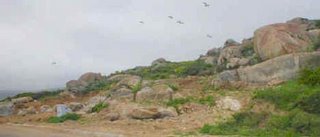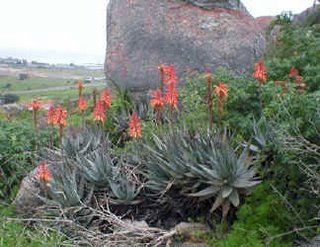Aloe ferox has a very wide habitat distribution in South Africa where this aloe has been used for its medicinal qualities for millennia. Only the gel of Aloe ferox (or any other aloe) should be used by the novice. The sap or bitter yellow exude originating from the green outer cells, can be used for its purgative effects, but it is not recommended as there are better and safer laxatives available.

This scene is to the left of the Breede river photo above.

How to prepare the gel

Cut the leaf in portions and peel off the green outer part. The gel is in the translucent leaf pulp. It is not bitter, in fact it is near to tasteless with only a slight "fresh" taste.
Fresh gel on the skin has a cool feeling. The gel is absorbed by the skin cells in seconds with only a thin silky layer that remains on the skin, giving the skin a
lovely silk smooth texture. The gel revitalizes the cells and the layer protects the skin on the outside.
Store the gel in an airtight container in the fridge for a few days only. It is better to freeze the gel in cubes for use and then remove a cube as needed.
The whole leaf can be stored in a cool dry place for a long time, even weeks. Cut off a portion of the leaf as needed.
The gel of most aloes (species or hybrids) can be used, but most aloes does not have much gel. Aloe barbadensis (known as Aloe vera) is well known for its gel. The gel is not as consentrated as the gel of Aloe ferox, but that does not matter. It is easy to cultivate Aloe vera from offshoots.
Aloe vera has been used for about 3000 years. The habitat of this aloe could be Arabia, but it has been cultivated for so long that the origin of this aloe has been lost in time.
Another South African aloe that is very good is Aloe maculata, also known as Aloe saponaria or the common name "soap aloe". The hybrid Aloe maculata x Aloe striata grows faster than Aloe maculata and it has the same high quality gel. The downside is that it is a much smaller plant than A.ferox or A.barbadensis, thus the gel is strictly speaking more expensive, but the gel is the best.
I take a teaspoon gel (mixed with any food or drink, it is tasteless) daily to build my immune system. I also give it to my pregnant cats in their food. I do not like to suggest anything to be taken internally, so please do it on you own risk. Do not take the green skin or sap! A quick rinse after you peeled the gel will remove the sap. A little sap would not hurt. If the gel taste bitter, then there is sap on it. eee-yuk .... do not believe the old tale that it has to taste awful to be good!

Aloe ferox is a large heavy aloe but it blooms from a young age at a relative small size. This easy growing aloe is an excellent focal point for a garden.




